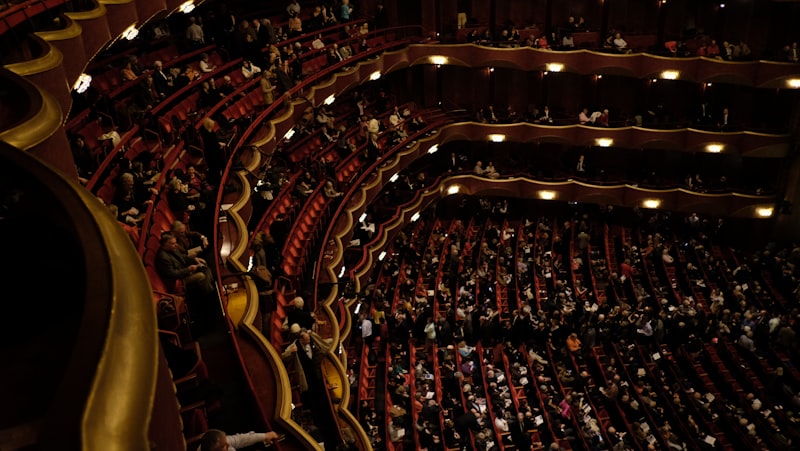Imagine stepping into the past as you enter the doors of Ford’s Theatre in Washington, D.C. This historic landmark is not only known for its theatrical productions but also for its pivotal role in American history. It was here that President Abraham Lincoln was assassinated in 1865, forever linking Ford’s Theatre with the legacy of one of America’s greatest leaders.
Moving westward, the Orpheum Theatre in Los Angeles stands as a testament to the opulence of the early 20th century. Its lavish interior transports you to a bygone era of Hollywood glamour, where stars once graced its stage under glittering chandeliers. The Orpheum has been lovingly preserved, making it a cherished cultural gem in the heart of LA.
Meanwhile, in New York City, the Apollo Theater in Harlem has been a beacon of African-American culture since the 1930s. It became famous for its Amateur Night, launching the careers of countless legendary performers like Ella Fitzgerald and Jimi Hendrix. The Apollo remains a symbol of resilience and creativity in the face of adversity, embodying the spirit of Harlem itself.
Traveling south to New Orleans, the Saenger Theatre enchants visitors with its ornate French Renaissance architecture. Surviving hurricanes and restorations, it has stood the test of time as a premier venue for Broadway shows and concerts. The Saenger is not just a theater; it’s a living monument to the resilience of New Orleans and its vibrant arts scene.
Finally, the Chicago Theatre in the Windy City is an architectural marvel, known for its iconic marquee and stunning interior. Since 1921, it has been a cultural hub, hosting everything from film premieres to live performances by top artists. The Chicago Theatre is not just a venue; it’s a symbol of Chicago’s rich cultural heritage and its enduring love affair with the arts.
These theaters are more than just buildings; they are living, breathing storytellers of America’s cultural history. Each one has its own unique tale to tell, weaving together the threads of art, history, and community. Whether you’re a history buff, a theater enthusiast, or simply looking to be captivated by a magical performance, America’s most historic theaters promise an unforgettable journey through time and culture.
Step Back in Time: Exploring America’s Oldest Theaters
One such gem is the Walnut Street Theatre in Philadelphia, Pennsylvania. Established in 1809, it holds the distinction of being the oldest continuously operating theater in the United States. Walking through its doors is like stepping into a time capsule of American theatrical history. From its elegant facade to its ornate interior, every corner whispers stories of legendary performances and theatrical innovations that have shaped the nation’s cultural landscape.
Moving southward, the Dock Street Theatre in Charleston, South Carolina, stands as a testament to resilience and revival. Originally opened in 1736, it was the first building in America designed specifically for theatrical performances. Destroyed by fire and rebuilt several times, the current structure dates back to the 1930s. Today, it continues to host a vibrant array of performances, blending historical charm with contemporary artistry.
Venturing westward, San Francisco’s Curran Theatre offers a glimpse into the city’s vibrant theatrical history. Opened in 1922, it has been a hub for groundbreaking productions and has hosted some of the biggest names in show business. Its majestic architecture and intimate ambiance create an unforgettable experience for theater enthusiasts and history buffs alike.
Each of these theaters tells a unique story of artistic evolution and cultural endurance. They have witnessed the evolution of American theater, from its humble beginnings to its current status as a cornerstone of artistic expression. Visiting these historic venues allows you to not only enjoy world-class performances but also to connect with the spirit of creativity and innovation that defines American culture.

As you explore America’s oldest theaters, take a moment to appreciate the passion and dedication that went into preserving these architectural treasures. They are more than just buildings; they are living monuments to the power of storytelling and the enduring magic of the stage. So, step back in time and experience the magic for yourself.
From Broadway to Hollywood: Iconic Theaters That Shaped American Entertainment
Broadway and Hollywood stand as pillars of American entertainment, each with its own allure and history. However, what ties them together are the iconic theaters that have become synonymous with legendary performances and cinematic history. These theaters are not merely venues; they are stages where dreams are born and legacies are etched into the annals of entertainment history.
One such legendary theater is the Beacon Theatre in New York City. Nestled on the Upper West Side, the Beacon Theatre has stood as a beacon of artistic expression since 1929. Known for its stunning Art Deco design and impeccable acoustics, the Beacon Theatre has hosted countless memorable performances ranging from rock concerts to comedy shows. Its intimate atmosphere and historical significance make it a cherished landmark in both Broadway and American cultural history.
Venturing westward to Los Angeles, the TCL Chinese Theatre emerges as a star in Hollywood’s constellation. Famous for its opulent Chinese-inspired architecture and the renowned handprints and footprints of celebrities immortalized in its forecourt, the TCL Chinese Theatre has been a premiere venue for movie premieres since 1927. The theatre’s grandeur and its close association with the glamour of Hollywood’s Golden Age make it a must-visit destination for cinephiles and tourists alike.
Another jewel in the crown of American theaters is the Radio City Music Hall in New York City. As the largest indoor theatre in the world when it opened in 1932, Radio City Music Hall remains an architectural marvel. Home to the iconic Rockettes and known for its Christmas Spectacular, the venue has become synonymous with grandeur and spectacular entertainment. Its annual holiday shows attract audiences from around the globe, making it a beloved institution in the heart of Manhattan.
These theaters are more than mere venues; they are storytellers in their own right, narrating tales of triumph, innovation, and cultural resonance. From the electric energy of Broadway to the star-studded glamour of Hollywood, these iconic theaters have shaped the landscape of American entertainment, leaving an indelible mark on the hearts and minds of audiences worldwide.
Hidden Gems: Uncovering America’s Forgotten Historic Theaters
Did you know that nestled in the heart of many American cities lie hidden gems that whisper tales of a bygone era? These are not just any theaters; they are historic treasures that have witnessed decades of cultural evolution and societal change. These forgotten theaters, often overshadowed by modern multiplexes, hold stories that are waiting to be discovered and retold.
Imagine stepping into a theater where the walls resonate with the echoes of performances that once captivated audiences from all walks of life. Each creak of the wooden floors tells a story of its own, a story that transcends time and transports you to a different epoch. These theaters are not mere buildings; they are living monuments to art, history, and the human spirit.
Take the Orpheum Theatre in New Orleans, for instance. Built in 1918, this majestic venue boasts a grandeur that is reminiscent of the golden age of theater. Its ornate architecture and opulent interiors harken back to an era when going to the theater was a glamorous affair. Today, the Orpheum stands as a testament to the resilience of historic preservation efforts, allowing visitors to experience the magic of live performances in a setting that is steeped in history.
Or consider the Fox Theatre in Detroit, a true architectural marvel. Designed by renowned architect C. Howard Crane and opened in 1928, the Fox Theatre is not just a theater; it is a masterpiece of Art Deco design. Its intricate details and lavish decor make it a feast for the eyes, transporting visitors to a time when elegance and grandeur were paramount.
These theaters are more than just relics of the past; they are cultural touchstones that connect us to our shared history. They remind us of the artists who graced their stages, the audiences who applauded their performances, and the communities that supported them. Visiting these hidden gems is like uncovering a long-lost treasure—a treasure that enriches our understanding of who we are and where we come from.
Behind the Curtains: Stories from America’s Most Haunted Theaters
Have you ever felt a chill down your spine in an empty theater, as if you were not alone? The world of theater holds more than just applause and drama—it harbors eerie tales and unexplained phenomena. America boasts some of the most haunted theaters, where ghostly apparitions and mysterious whispers are part of the nightly performance.
In the heart of New York City, the Belasco Theatre stands as a beacon of both Broadway glamour and ghostly encounters. Legend has it that the spirit of David Belasco, the theater’s original owner, still lingers in the shadows, overseeing rehearsals and performances alike. Actors and stagehands have reported seeing a figure in an old-fashioned suit walking the halls or sitting in the audience, his presence felt long after the final curtain falls.
Traveling south to New Orleans, the historic Le Petit Théâtre du Vieux Carré holds its own spectral secrets. Built over two centuries ago, this theater has seen its fair share of tragedies, leaving behind lingering spirits. From the ghostly figure of a woman in white seen gliding across the stage to inexplicable cold spots and phantom footsteps backstage, visitors often find themselves captivated by more than just the productions.
Not to be outdone, Chicago’s Oriental Theatre, now known as the James M. Nederlander Theatre, has its own ghostly lore. Built in 1926, it is said to be haunted by a former stagehand who met an untimely end during its construction. His presence is often felt by those working late nights, with tools mysteriously moving and lights flickering without cause.
Architectural Marvels: America’s Most Stunning Historic Theaters
One such gem is the iconic Beacon Theatre in New York City. Built in the 1920s, its Art Deco design and lavish interiors transport visitors to a bygone era of glamour and sophistication. The theater has hosted legendary performances by artists ranging from the Rolling Stones to Queen, adding a modern vibrancy to its historic walls.
Venturing westward, Chicago’s Auditorium Theatre emerges as a masterpiece of Richardsonian Romanesque architecture. Designed by Louis Sullivan and Dankmar Adler, it opened in 1889 and boasts intricate details that include ornate ceilings and majestic balconies. The theater continues to be a cultural hub, showcasing a variety of performances from ballet to Broadway musicals.
Moving southward to the city of angels, the Los Angeles Theatre stands tall as a testament to Hollywood’s golden age. This opulent movie palace, with its lavish French Baroque interior, evokes a sense of cinematic nostalgia. The theater’s grand chandeliers and intricate murals have graced countless film premieres and live performances, making it a cornerstone of LA’s cultural landscape.

Further along the eastern seaboard, the Fox Theatre in Atlanta captivates visitors with its stunning Arabian-themed design. Opened in 1929, its colorful domes and minarets create an enchanting ambiance that transports guests to distant lands. The theater hosts a diverse array of events, from concerts to Broadway shows, ensuring its legacy as a beacon of Southern hospitality and architectural splendor.
Frequently Asked Questions
What are the oldest historic theaters in the United States?
Discover some of the oldest historic theaters in the United States with rich cultural legacies and architectural significance.
What makes a theater ‘historic’ in the context of American culture?
Discover what defines a theater as ‘historic’ in American culture. Explore how its architectural significance, cultural impact, and historical events hosted contribute to its designation. Learn about the criteria that elevate theaters to historic status and their enduring significance in shaping cultural narratives.
Where can I find tours and guided visits to iconic American theaters?
Discover where to find tours and guided visits to iconic American theaters with ease. Our FAQ provides clear, concise directions to ensure you enjoy an enriching experience at these cultural landmarks.
Why are historic theaters like the Fox Theatre and Radio City Music Hall important to American history and culture?
Discover why historic theaters such as the Fox Theatre and Radio City Music Hall are crucial to American history and culture. These iconic venues not only showcase architectural brilliance but also serve as cultural landmarks where generations have gathered to enjoy entertainment that reflects the nation’s evolving artistic and societal tapestry.
How can I visit famous theaters like the Apollo and Broadway in America?
Learn how to visit renowned theaters like Apollo and Broadway in America by checking their official websites for show schedules and tickets. Plan ahead as popular shows may sell out quickly. Consider guided tours for insights into theater history and architecture. Ensure to follow venue-specific guidelines for a memorable visit.



